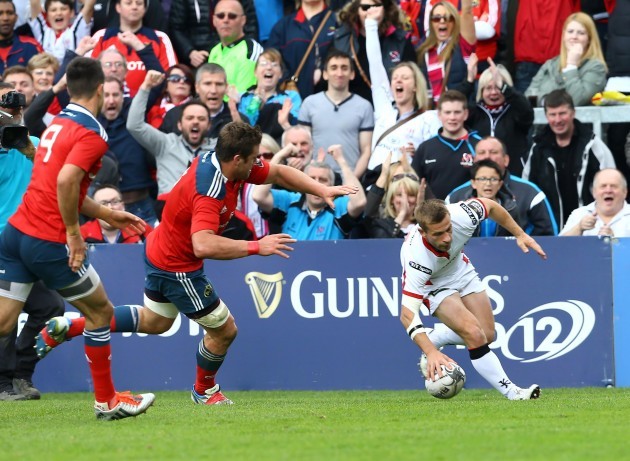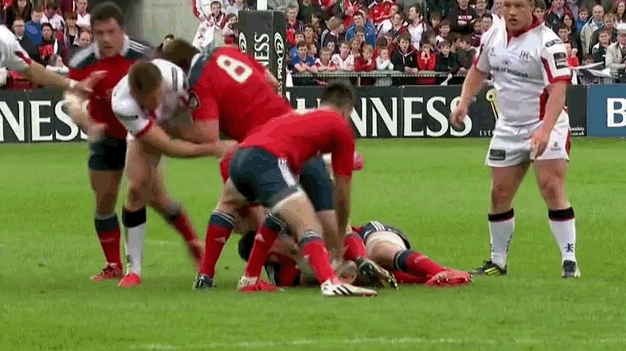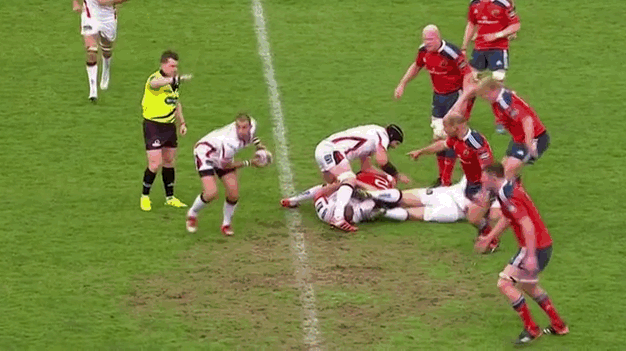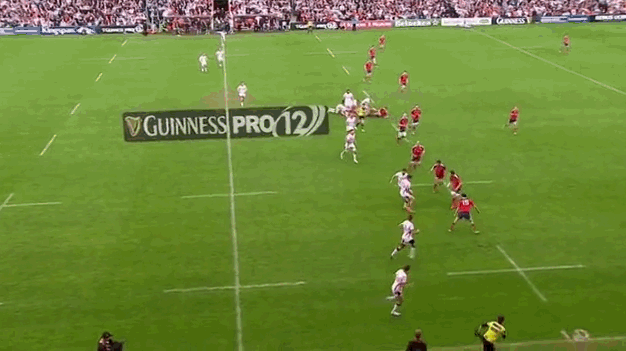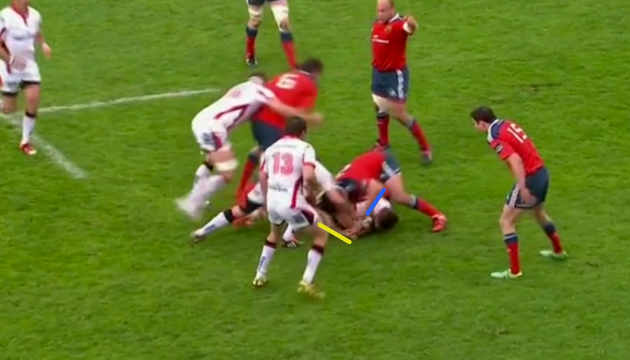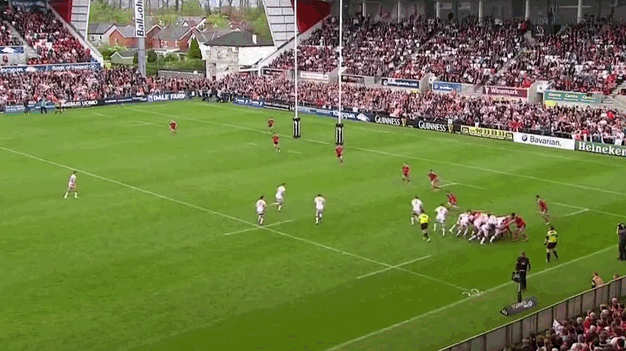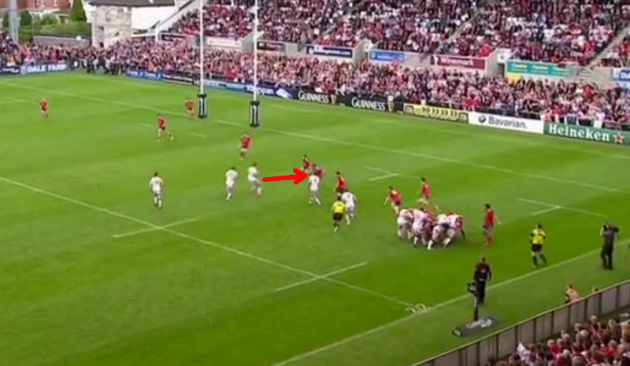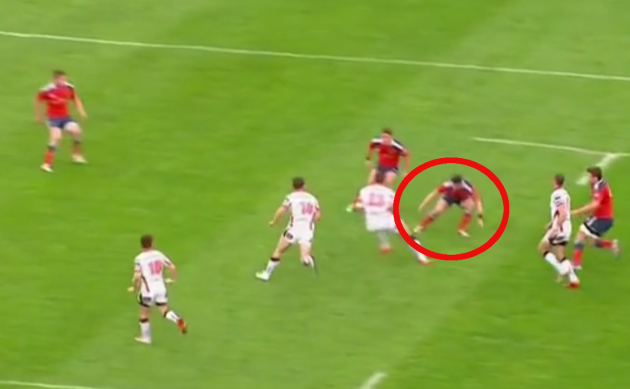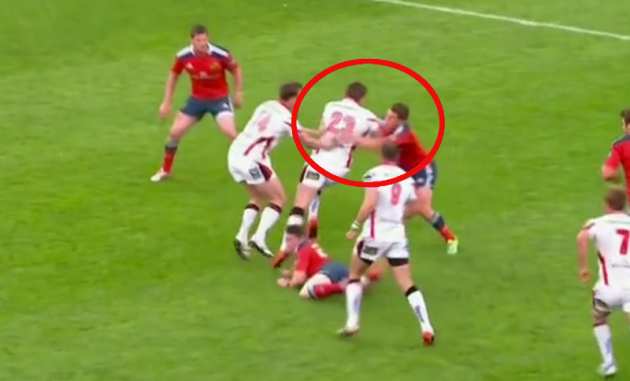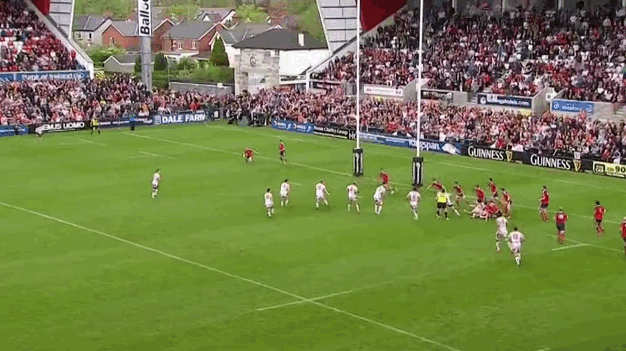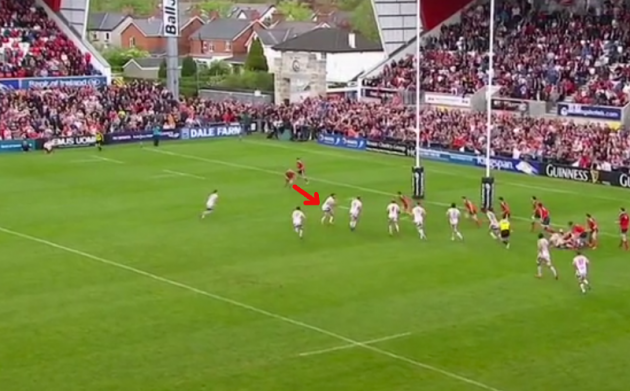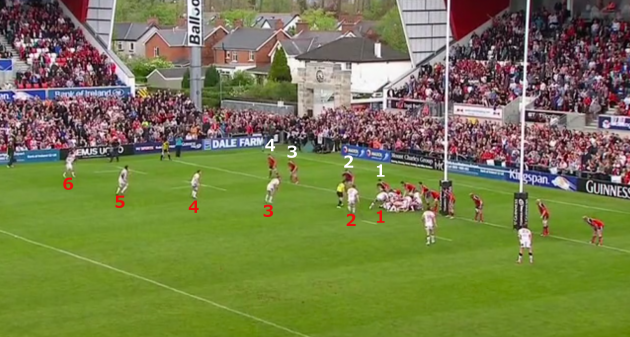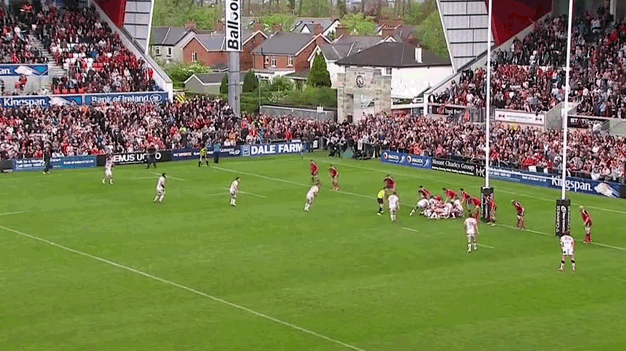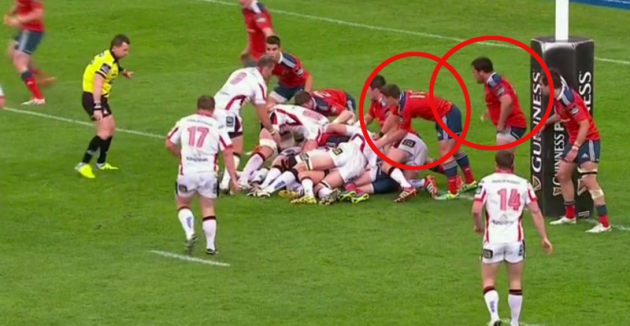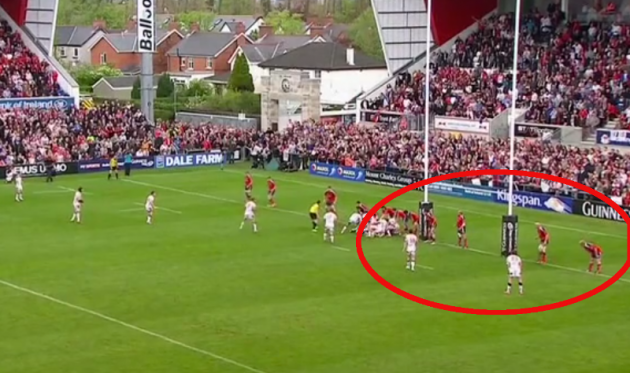TWICE IN CONTROL of the game as the end of the halves approached, Munster finished up with a draw on Saturday against Ulster when a win had looked extremely likely.
In an earlier piece, we looked at the Tommy Bowe try just before half time that meant Munster’s 9-3 lead became a 10-9 deficit at the break and here we turn our attention to the Paul Marshall score that meant Anthony Foley’s men gave up a winning position.
With two minutes remaining on the clock, Munster 23-16 ahead and Ulster down to 14 men, Foley could have been forgiven for thinking his side would see out a crucial victory to move to the top of the Guinness Pro12 table.
Instead, their numerical advantage failed to tell as Neil Doak’s Ulstermen manufactured an excellent try at the death to allow Paddy Jackson’s conversion to level the game. Let’s take a look at how exactly that happened.
78:06
Having scored themselves through Keith Earls in the 76th minute, Munster received Ulster’s restart through the aerial strength of Paul O’Connell and played a single phase to the left before Conor Murray box kicked up to the halfway line.
Should Munster have looked to retain possession at this stage, with the match clock reading 78:06? Two minutes of running down the clock is a difficult thing to do and anything more ambitious than narrow phases with ball in hand would have been risky.
Munster were almost certainly conscious of Nigel Owen’s history in terms of refereeing sides as they attempt to ‘negatively’ run the clock down in winning positions too.
Ireland vs. New Zealand in 2013, Racing Métro vs. Saracens in 2015; there are other examples too. The decision to box kick out of their defensive third was a sensible one in this instance, and Felix Jones very nearly won the ball in the air against Louis Ludik.
Unfortunately for Foley’s men, Jones knocks the ball on as he contests and Bowe regathers to allow Ulster to go on the attack. Hardly a disaster for Munster; with their 15 men up against 14, they would have backed themselves to hold firm.
78:36
Ulster manage to make around 12 metres of progress over their eight phases of attack, the large majority of those coming through an excellent carry from replacement centre Stuart McCloskey.
Munster begin the above phase in decent shape defensively, though a slight dog leg either side of CJ Stander catches the eye of the powerful McCloskey, who then fakes a pass and turns on the acceleration to get outside the Munster number eight.
Stander recovers to grab McCloskey and haul him down but the Bangor man has the athleticism to haul himself towards Munster’s 10-metre line before going to ground. His first major contribution of an important two minutes of play.
79:20
Munster recover their defensive shape well over the next few phases to pressure Ulster, almost regaining possession after a loose Jared Payne pass hits the deck, but then they conceded a needless penalty at the breakdown.
With their one-man advantage, Munster can certainly afford to have an effort at winning a game-clinching turnover in these phases and Paul O’Connell had two attempts before this penalty comes.
Crucially, the Ireland captain didn’t push Owens too far, listening to the Welsh referee’s calls of ‘release!’ and ‘you’ve lost it now!’. In the above instance, hooker Eusebio Guiñazú doesn’t heed the warning and Munster pay the price.
Owens gives Guiñazú a chance to clear himself away from the ball – ‘release!’ – but the Argentinian international, who had a strong outing otherwise, remains clamped onto it and the penalty decision follows just over a second later.
It’s an entirely fair call from Owens in this case, as Guiñazú fails to show a clear release between being involved in the tackle on McCloskey and his attempt to pilfer the ball. As we can see above, his left arm [blue] does come clear of the tackle, but his right arm [yellow] remains attached throughout.
With Owens observing from that side of the ruck, there’s not going to be any benefit of doubt given and the penalty comes. It’s sloppy from Munster, who had been defending well despite that big burst from McCloskey.
With just 40 seconds of the game remaining when Guiñazú goes in for the ball, Foley’s 15 men would probably have been better served by continuing to show patience defensively, either forcing an Ulster error or pouncing when a more suitable turnover chance came.
80:15
With the penalty conceded, Paddy Jackson kicks Ulster to within 10 metres of the Munster tryline, exactly where they don’t want to be at this stage of the game. The clock is in the red, but the home side have one final attempt to save themselves.
Ulster do so in thrilling fashion, but Munster will have looked at their own shortcomings in their video review session today as they begin preparations for the visit of the Dragons to Cork on Saturday.
Having competed well in the air throughout the game, Munster opt to remain on the ground at this final lineout, understandably expecting a mauling effort from Franco van der Merwe and his Ulster pack.
That’s exactly what comes and the well-prepared Munster forwards deal with the maul exceptionally well, shunting it back a metre and bringing the call of ‘once’ from Nigel Owens.
Scrum-half Ruan Pienaar shifts the ball away from the tail and the most decisive moment of Ulster’s try-scoring attacking follows.
It’s a superb carry from McCloskey again, as he beats the first tackler and then drags two more Munster defenders into contact as he powers towards the visitors’ tryline, forcing them into an immediate and alarming scramble situation.
At 6ft 4ins and nearing 110kg of mass, much of the focus around McCloskey can be on his sheer size, but this example once again demonstrates his superb pre-contact footwork.
The 22-year-old so often gives himself opportunities to use his power through tackle attempts by shifting his feet at the last moment, driving off at a different angle to that which the defender is expecting.
In this instance, McCloskey arrives onto Pienaar’s flat pass on a hard ‘unders’ line, typical of an imposing centre carrying off a set-piece platform as they look to set a strong target for their team.
Munster wing Ronan O’Mahony, defending as part of the frontline, reads that line and sets himself for the hit on McCloskey, but the Ulster centre shows rapid footwork to re-adjust at speed and push back outside off his right foot.
Many men of McCloskey’s height struggle greatly to shift direction in this manner, not possessing the fast-twitch fibres and agility required, but the Ulster youngster is an athlete of exceptional standards and this is becoming the norm in his carrying.
When we shift the angle around to behind McCloskey [below], we get a better view of what his original line has caused O’Mahony to do.
The Munster wing, who impressed with his own dynamism after replacing Simon Zebo in the first half, has completely ‘sat down’ upon reading that unders line from McCloskey, expecting to make a tackle on his inside shoulder.
Just outside O’Mahony, we can see that Keatley has identified the same threat, which means that he’s in a poor position to re-adjust when McCloskey turns on the footwork.
As a result, Keatley goes in high in the tackle [below] and that simply allows McCloskey to use his upper body power.
Munster’s inside centre Denis Hurley is then forced to turn in and make the rescuing tackle, meaning Foley’s side have used three defenders to halt the one Ulsterman. Their numerical advantage is swiftly reduced in a moment of class from McCloskey.
Just a minute after having been defending on their 10-metre line against 14 Ulster attackers, 15-man Munster are deep in the shit five metres from their own tryline after McCloskey has managed to negate the numerical advantage in a single carry.
80:31
Strong rucking by Bowe and Chris Henry removes the turnover threat of CJ Stander after Hurley and Keatley do manage to bring McCloskey to a halt, meaning Ulster can play away to the left with quick ball.
Obviously, it’s difficult for the Munster pack to get back towards the point of contact and therefore around the corner of the ruck to defend on the far side, meaning Ulster would have backed themselves to score on second phase.
With O’Mahony, Keatley and Hurley all out of the game, it takes a superb saving hit from right wing Keith Earls to prevent Payne from crossing after Pienaar finds the Ireland international centre.
Earls realises that Andrew Smith, the man closest to him on the inside, is getting off the line hard in an effort to shut down Ulster’s space, leaving a hole on the outside for Payne to target.
Showing superb reaction skills, Earls turns in and confronts Payne as he heads for the tryline. The tackle selection is ideal in this instance, with Earls recognising that a low tackle is not going to be sufficient to prevent Payne from stretching out to score.
Instead, he gets a firm upper body shot on Payne and wraps the Ulster centre, also meaning that he can add a bit of time to the ruck on the ground with a slow release of the tackled player.
80:43
It saves Munster for another few seconds, but the inevitable comes on phase three.
Let’s take a look at the defensive situation Munster are presented with on this try-scoring phase. Needless to say, it ain’t pretty.
Munster have four viable defenders on the left side of the ruck as we look at the image above, Conor Murray [white 1] is in the ‘pillar’ position on the edge of the ruck, Donnacha Ryan [2] is in the ‘A’ position, with Denis Hurley [3] and CJ Stander [4] further out the line.
There is an additional Munster defender in play here, Jack O’Donoghue halfway between being part of the ruck and being the pillar. The Waterford man is not really in a position to totally vacate the ruck, however, given the danger of Robbie Diack picking the ball out and simply falling over the line to score.
With Callum Black [red 2] hovering behind the ruck, Ulster have six attacking bodies available when we include scrum-half Ruan Pienaar [1].
Clearly Munster are numbers down and the real difficulty for them here is that Murray and Ryan have to worry about the threats close to the ruck. Murray needs to guard that pillar area intently, while Ryan has to worry about Black appearing late, Pienaar sniping on an arcing line and, due to the lack of numbers, Chris Henry [3] in front of him.
It’s just a nasty defensive situation and with Pienaar firing an accurate pass out the back of Henry to out-half Jackson [4], Ulster are presented with a straight-forward three-on-two on the edge.
Could Hurley and Stander have come up with greater linespeed out there to shut down the long passing option? Possibly, but that would have left them vulnerable to a Jackson show and go, or even a floated pass wide over their heads to Marshall on the touchline.
As it is, the pass from an in-form Jackson is perfect as he skirts the ball outside the final two Munster defenders.
80:40
We also have to ask whether Munster could have got additional bodies around the corner on his final phase, therefore giving themselves a far greater opportunity of shutting down Ulster’s play.
Looking back at that final Ulster ruck, we can see a couple of bodies on Munster’s left side filling the pillar and A positions. This is almost an eight-second ruck for Ulster, as Earls, Felix Jones and Peter O’Mahony manage to greatly slow the ball.
Ulster’s go-forward momentum makes it more difficult for Munster to fold around the corner defensively, although Hurley and Ryan mange to do so. Could Munster have brought even one more body around?
Keatley is in position as the pillar on Munster’s left side of the ruck, and generally most teams operate under the rule that the pillar never vacates his position. If the team is going to fold, they’ll often shift the A defender across.
Even if that is the defensive rule Munster operate under, the rules go out the window when you’re camped on your tryline and attempting to hold out. The duration of the ruck in this instance gives Munster ample time to get another body or two around the corner.
Guiñazú is present as the man outside Keatley, and he even gives the Munster out-half a tap to indicate that he can fold over to Munster’s right-hand side.
Whoever it is to fold, Munster simply need to get another body or two across before Pienaar passes, but that doesn’t happen. That leaves six Munster defenders on the left side of the ruck against two Ulster attacker and a possible Pienaar snipe.
Ulster are numbers up on the left and take their chance clinically to provide Jackson with the chance to level the game.
